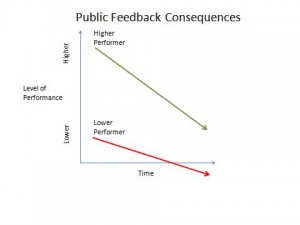Public feedback drives performance down and doesn’t count as performance management
My two previous blog posts have been about “public feedback.” Public feedback is the commonly observed phenomenon where a manager tries to correct the behavior of a few individuals through mass-communication channels such as email or a large-group meeting. Common examples are, “We have a dress code” or “We need to stop the gossiping.” In my first blog post on the subject, I describe how this doesn’t change – or even makes worse – the behavior of the people who are behaving incorrectly. In my second post on the subject, I describe the impact on those who are actually behaving correctly (it throws them out of whack).
OK, so it doesn’t work with the people who you are targeting, and it messing up with the people you aren’t targeting. But what about you, the manager? It messes you up too!
When giving public feedback, the manager is trying to take a shortcut and address several performance issues at once. We’ve already established that it doesn’t work, so that should be enough. Here’s how this short cut plays out.
Let’s take a look at the dress-code violator example. In this example, you have two out of fifty people who are iffy on adhering to the dress code. You send an email to the group saying that everyone needs to adhere to the dress code. Now, what happens if the two individuals don’t immediately improve the way they dress?
First, it tells everyone on the team that you are ineffective, opening the door for more poor behavior.
You have already publically announced that you are trying to address this issue – yet things haven’t changed at all. It is a clear signal that when you, the manager, attempts to get something done – to effect change in your organization – you can’t get it done. This means that on not only this issue, but on all other issues, you are incapable of managing your team on something as simple as the dress code. Some members of your team may take advantage of this and be inspired to engage in other undesirable behaviors, such as not doing their prescribed work, sabotaging other worker’s efforts, and the like. Now you’ve got a bigger problem, and it’s not limited to just the dress code.
In addition, what about those on your team who try to do the right thing? Those who find it objectionable that other team members are testing your boundaries? Those who continue to try to do the work at hand? Well now they are in a bind. Do they themselves try to correct the behavior of those pushing the limits? If they do, they already know that you will be ineffective at supporting their efforts. So they probably won’t try. Add up the cumulative effects of lack of teamwork, lack of incentive to keep performance high, and the general frustration that things are getting worse, rather than better, you get a team declining in performance.
It’s a double whammy: The lower performers (those who would actually consider slacking off work based on managerial weakness) get worse, and the higher performers (those who would not consider slacking off because of managerial weakness) disengage from trying to improve the team capability, making them, in effect lower performers. Here’s a simple chart showing the impact over time:
Yes, performance can get into the damaging zone, as employees who can hide behind the public feedback discover new ways to underperform or actually do damage. Multiply this across the number of people on your team, and the results become similar to what the Society of HR Managers have discovered – that six out of 10 Americans identify poor managers as the number one obstacle to productivity (cited here).
But wait, there’s more! Here’s one more reason public corrective feedback makes the manager’s job harder:
It’s completely external to the performance management process.
A previous post, “Performance Management: Were You Aware of It?” describes how the performance management process is designed for dealing with underperformers, belligerent employees, and the like. With the performance management process, you can systemically address performance problems. This is the actual process that managers are supposed to use to address performance problems on their team. However, in the example of a manager trying to correct behavior using “public feedback,” doing this fit nowhere in the performance management process.
The performance management process describes how if you are trying to correct an employee’s behavior, a key task is to give feedback to the employee about what it is they are doing and what should be changed. Providing public feedback simply doesn’t count. So when the manager actually correctly starts the performance management process and sits down with the employee to discuss the behavior, the manager is essentially starting from the beginning. Discussions about the email sent, the message at the all-team meeting – all of that doesn’t count. The manager cannot state, for example, “I sent out an all-team email saying that gossiping would not be allowed.” The gossipy employee simply has to state, “I didn’t know that this was addressed specifically to me. I thought I was performing correctly.” And the gossipy employee is right. Well played, gossipy employee, well played!
Given this, the manager who wants to improve the behavior of an employee has to do the individual feedback and performance management process anyway. So the short cut of the public feedback was a waste of time. And if you look at the chart above, the manager probably now has more performance problems to deal with.
For you management designers out there, how would you design it so that managers trend away from providing public corrective feedback, and instead focus on giving specific and immediate feedback?
I’d also love to hear in the comments your examples of when managers have tried to correct behavior problems through announcements.
